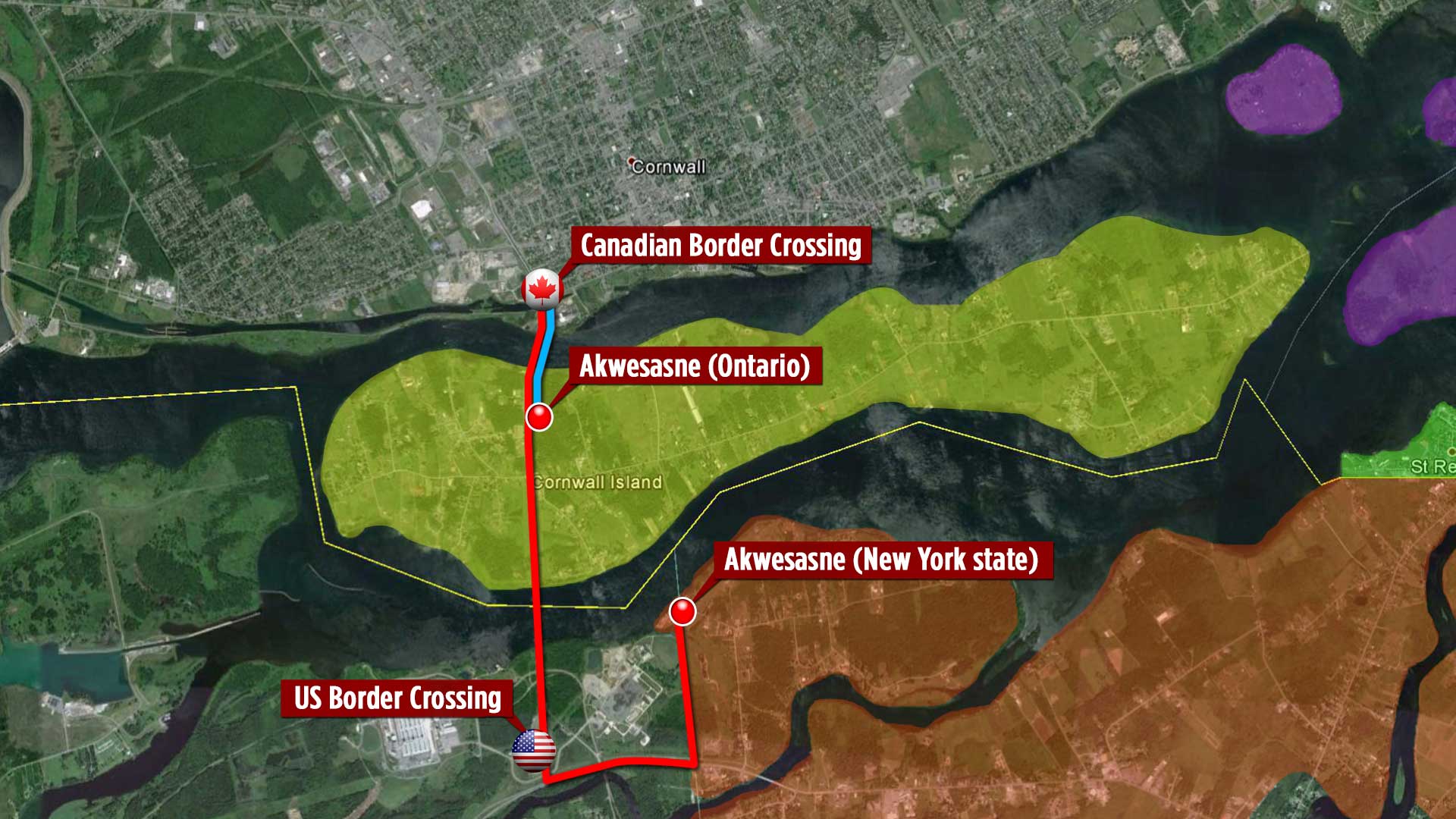MNN. THE FOLLOWING REPORT WAS READ ON KRK1:30 RADIO KAHNAWAKE @ 12:35 PM MON. FEB. 5/24.
“Feb 5, 2024: as read on K103 Radio, Kahnawake at 12:35
Time Sensitive: Let’s talk about Air Products & Chemicals Inc.
 Nine years ago, I began working in Akwesasne as a family physician. One of the strong currents underlying the health of Akwesasro:non is that the environment is heavily polluted and that many of the people are sick. The high levels of PCBs, lead, mercury, benzene, fluoride, dioxins, arsenic, and cyanide have been documented in many research studies in Akwesasne and are felt to be responsible for the elevated levels of cancers, diabetes, mental health illnesses like dementia and depression, developmental disorders in children, and endocrine and autoimmune disease.
Nine years ago, I began working in Akwesasne as a family physician. One of the strong currents underlying the health of Akwesasro:non is that the environment is heavily polluted and that many of the people are sick. The high levels of PCBs, lead, mercury, benzene, fluoride, dioxins, arsenic, and cyanide have been documented in many research studies in Akwesasne and are felt to be responsible for the elevated levels of cancers, diabetes, mental health illnesses like dementia and depression, developmental disorders in children, and endocrine and autoimmune disease.
The corporations responsible for this air, water, and soil pollution have done extensive remediation to decrease these chemicals in the environment. But it is never enough. People are still asked to eat only a small amount of fish, garden in soil that is brought from elsewhere, not pick medicines in certain areas, and of course not to drink untreated water from the Kaniatarawenen:en, or the St. Lawrence River. We have a responsibility to be on constant vigilance, stewarding the lands against further damage, so that our ‘Coming Faces’ will be able to live in a healthy environment.
In July 2022, the United Nations officially recognized that a clean, healthy, and sustainable environment is a human right. Both Canada and the United States have also recognized this right. At the same time, to mitigate Climate change, both countries are looking for energy solutions that do not emit carbon into the atmosphere. One company, Air Products and Chemicals Inc., aims to make hydrogen fuel in a facility that will be built in Massena, NY, adjacent and upriver from Akwesasne. I have read all the available documentation.
Specifically, Air Products & Chemicals Inc., will take water from the St. Lawrence River, clean this water using treatment chemicals called ‘biocide’, and then subject it to an electric current, called ‘electrolysis’, and break the water molecules into its component parts of hydrogen and oxygen. The oxygen will be released into the atmosphere, and the hydrogen will be dried, liquified, stored in tankers, and then driven by trucks 500 miles away to be used in the travel industry as clean fuel. It is considered clean because the energy used to make the hydrogen is hydroelectric. The effluent, or waste from the plant, will consist mostly of water, and at 90-degree F will be disposed of into the nearby Grasse River via the Massena Canal. Right now, Air Products & Chemicals Inc., are applying for aState Pollutant Discharge Elimination System (SPDES) Permit to discharge this waste into the river.
There are concerns about many aspects of this project: there are wetlands to be disturbed, trees to be clear cut, and the homes of endangered species like the Northern Long Eared bat and the Monarch butterfly may be affected. Would 90 degrees F water cause thermal pollution to the Grasse River? Would the armoured and sediment cap that has been placed over the riverbed of the Grasse River, sequestering the previous pollution, be affected, and breached? Is it safe to drive hydrogen fuel through our community? Are there truly no archeological sites in the area? The documents that I have read are very detailed, and using science and regulations, Air Products & Chemicals Inc. have done their due diligence and answered most of these questions.
However, we should have a persistent concern. Air Products & Chemicals Inc plans to send its effluent into the Massena Canal. The Massena Canal was built in 1893, flows into the Grasse River, previously provided hydroelectricity to the Alcoa plant, and is no longer in use. The Massena Canal was NOT part of Alcoa’s remediation plan. Will this effluent from the Air Products & Chemicals Inc. discharged into the Massena Canal disrupt the sediment on the canal’s bottom? What is the depth and the flow rate of the canal waters? What does its sediment contain? Does this sediment contain high levels of PCBs that will then be carried to the Grasse River, over the riverbed armoured cap, right to the waters of Akwesasne?
The Air Products report says, “No significant socioeconomic impacts are expected, and the proposed project is not anticipated to result in disproportionately high or adverse impacts to low income and/or minority populations. Subsequently, no mitigation measures are proposed”. The proposed site is also described as ‘previously undeveloped with no history of industrial activity’. These statements are not true. We are downwind and downstream of three Superfund sites in the adjacent areas of this proposed project. There are many research studies that have shown the deleterious effects of contaminants from these Superfund sites on the health of the people of Akwesasne. Superfund sites are polluted locations in the United States requiring a long-term response to clean up their hazardous non-usable material. The Grasse River remediation project was only completed in 2021, but the area has never been remediated to its natural state.
Akwesasne was not listed as a special interest group. Akwesasne was not officially invited to any information and consultation sessions. Notices were only posted in the Watertown and Massena newspapers. Akwesasne community members who attended the July 12, 2023, meeting were reassured that Air Products & Chemicals Inc. would hold an information session in Akwesasne later. Despite many attempts to contact Air Products & Chemicals Inc., this meeting never happened, and the information was eventually obtained through a freedom of information application to the Department of Environmental Conservation (DEC).
Given that we are downstream, adjacent to Massena, and have a very public, historic, ongoing, adverse, distrusting relationship with the corporations responsible for the three Superfund sites, we wonder why our people were deliberately kept out of the plans for this project. We became substantively aware of this project two weeks ago. We have until February 8, 2024, to make our concerns known to the DEC who evaluate the SPDES Permit of Air Products & Chemicals Inc.
I would add at this moment that we, as stewards of our mother, as Okwehonwe — we don’t rip apart the molecules of our mother’s water. We protect the water, give thanks to the water- industrialism no matter how it’s advertised as being “green”, it’s painted, and is about money. They will always have the underlying desire to separate us from the relationships we have to the air, water, and plant life. We must make our voices heard and protect ever acre of wetlands we have. We must make our voices heard and not allow the sleeping waters that contain the contaminated sediment to be awakened.
As it stands, the SPDES permit must be denied or at least delayed. Your voice matters. Please- write, email, or call the DEC and urge them to deny Air Products & Chemicals Inc. the SPDES permit.
Miranda Gilgore, NYSDEC Region & Headquarters
State Office Building – 317 Washington St, Watertown, NY 13601
Phone: (315) 785-2245
Email: DEP.R6@dec.ny.gov
Ojistoh Horn, MSc, MD, CCFP”
Deep Purple sang about this. “Smoke on the water”. “We all came out to Montreux on the Lake Geneva shoreline to make records with a mobile. We didn’t have much time. “Frank Zappa and the Mothers” were at the best place in town. Until some stupid with a flare gun burned the place to the ground. Smoke on the water, fire in the sky. Smoke on the water, fire in the sky…
https://www.youtube.com/watch?v=krBTb6ga-MMbox 991, kahnawake, quebed canada. J0L 1B0



